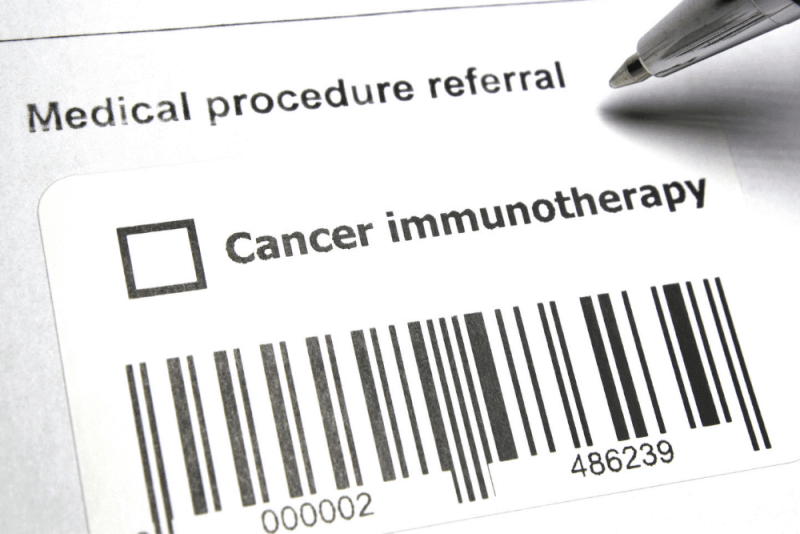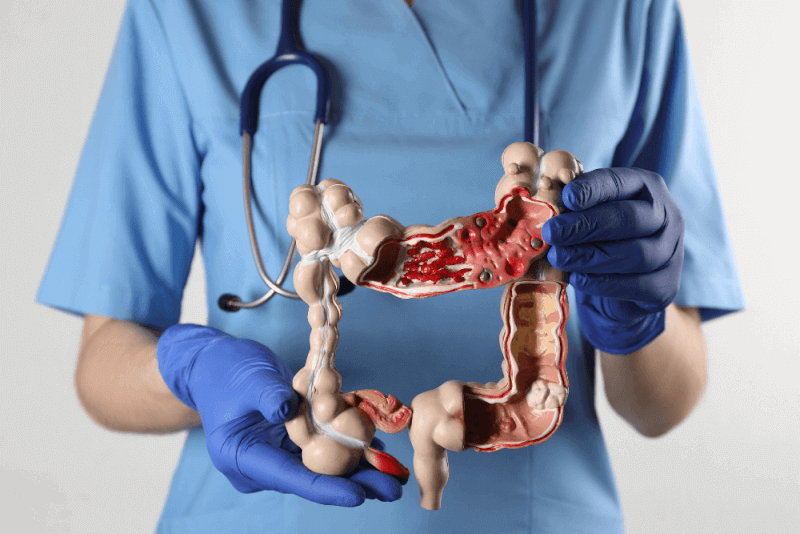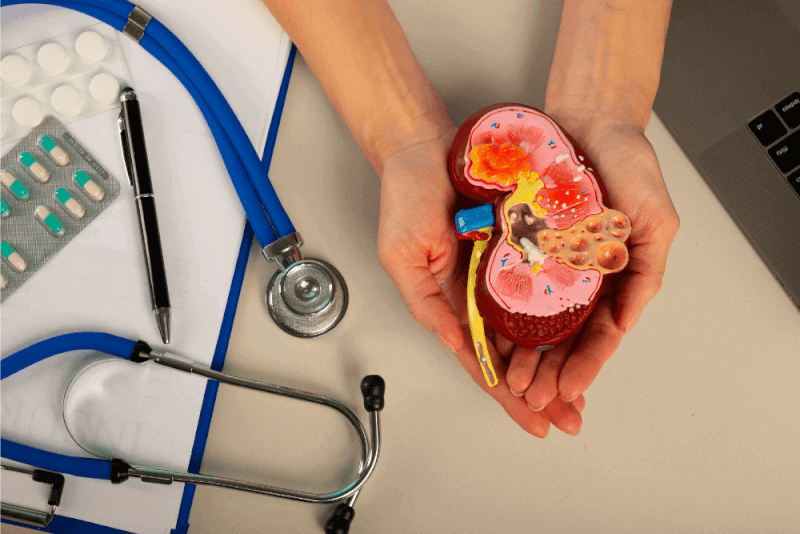30 Second Summary
- The most characteristic symptom of esophageal cancer is difficulty swallowing.
- The most important risk factors are smoking, alcohol, reflux, obesity and genetics.
- Treatment includes surgical procedures, chemoradiotherapy and targeted therapies.
- Treatment depends on the stage of the cancer and the general health of the patient.
What is esophageal cancer?
The 7th most common. esophageal cancer is a type of cancer that occurs in the esophagus, which is approximately 25-30 cm long, starting from the neck and extending to the stomach. It is also called esophageal cancer.
Types of esophageal cancer
Esophageal cancer varies according to the type of cells affected. It is therefore divided into two main groups:
Squamous cell carcinoma
The inner surface of the esophagus in contact with food is covered with flat epithelial cells. When these cells proliferate uncontrollably, a type of cancer called squamous cell carcinoma develops. This type of cancer, also called squamous cell cancer, is one of the types of esophageal cancer.
Adenocarcinoma
Esophageal cancer usually occurs in the lower part of the esophagus. Affected by stomach contents, this part begins to resemble cells in the digestive system. After this point, it multiplies uncontrollably and becomes cancerous. This condition is called esophageal adenocarcinoma.
Diagnosis of esophageal cancer
In the diagnosis of esophageal cancer, which has characteristic symptoms such as difficulty swallowing and unexplained weight loss, the medical history of the patients is first listened to and then a physical examination is performed. Patients are then asked to undergo tests to determine whether there is a tumor causing the symptoms.
Endoscopy
Endoscopy is the primary examination method used in the diagnosis of esophageal cancer. In this examination, a thin tube with a camera at the end is used to visualize the esophagus from the inside. If deemed necessary by the physician, samples for pathological examination can be taken in the same procedure.
X-ray of the esophagus and stomach
This test, also called barium swallowing test, is used to visualize structural changes in the esophagus of patients. This requires the consumption of a liquid medicine that can be visualized under X-rays. At the same time as the medicine is swallowed, imaging is performed. This allows physical changes in the esophagus to be recognized.
Computed tomography
If esophageal cancer is suspected, computed tomography is used to determine whether the tumor has metastasized to surrounding organs. Tumors in the esophagus are especially likely to metastasize to the liver and lung.
Endoscopic ultrasonography
This method is similar to endoscopy. However, imaging is done with sound waves. The aim of this examination is to determine the spread of the tumor in the esophagus, the status of the lymph nodes and the depth of the tumor.
Positron emission tomography
This test, called PET for short, is a nuclear test. This test, which measures the activity of cells, can also provide information about possible cancer sites. PET scanning is particularly used to detect metastasis to distant sites.
Symptoms of esophageal cancer
The most characteristic symptom of esophageal cancer is difficulty swallowing. In addition, the symptoms seen in patients include the following:
- Hiccups that won't go away
- Chest pain
- Heartburn
- Weight loss
- Pain in the throat when swallowing food
- Vomiting
- Food coming back into the mouth
- Feeling of pressure in the chest
- Burning in the chest
- Heartburn
- Cough
- Coarsening of the voice
- Bleeding
- Persistent fatigue
- Black or tar-colored stools
- Development of anemia due to bleeding
- Fatigue
Causes of esophagus (esophagus)
As with other types of cancer, the underlying factors of esophageal cancer can be very diverse. On the other hand, the exact cause of esophageal cancer has not yet been proven by research. However, these studies have shown that some factors increase the risk of esophageal cancer.
Family history
People whose close relatives, especially first-degree relatives, have esophageal or stomach cancer are more likely to develop esophageal cancer. This is considered to be an indication that the person is susceptible to cancers of the digestive system.
Smoking and alcohol consumption
Smoking and alcohol use both cause irritation of the esophagus and genetic mutations. This significantly increases the risk of esophageal cancer.
Reflux disease
If stomach or bile contents escape back into the esophagus, the tissues in the esophagus can be severely damaged. Prolonged duration of this condition causes structural changes in the esophagus. With this change, the structure of the cells in the esophagus changes to that of the cells in the digestive tract. This condition is called Barrett's esophagus and these lesions increase the risk of developing esophageal cancer.
Obesity
Problems such as reflux increase when body weight is much higher than the ideal weight. This increases the risk of developing esophageal cancer in people with obesity.
Esophageal diseases
Some structural diseases that prevent food from passing into the stomach cause changes in the structure of the esophagus. Damage to the tissues here also increases the risk of cancer.
Consumption of foods that irritate the esophagus
Consuming very hot food and drinks causes damage to the esophagus. This is one of the factors that increase the risk of esophageal cancer.
Radiation
Exposure of the abdomen, neck or chest to high doses of radiation increases the risk of the tissues developing tumors.
Malnutrition
Inadequate consumption of fruits and vegetables increases the risk of esophageal cancer. Because the vitamins and minerals as well as antioxidants found in fruits and vegetables protect people from esophageal cancer.
Esophageal cancer treatment methods
The treatment of esophageal cancer is planned according to the type and stage of the cancer and the general health status of the patient. Surgical options are generally preferred in the treatment of esophageal cancer. It is also combined with other treatments.
Removal of small tumors
Endoscopy is used in this treatment method applied in esophageal cancers in the first stage. In order for this method to be applied, the cells must not yet be cancerous, but there must be a possibility of cancer or the cancer cells must only be superficial. Patients who meet these conditions undergo an endoscopy procedure, during which the dangerous tissues are removed along with nearby healthy tissues.
Esophagectomy
In this procedure, the entire esophagus and, in some cases, part of the stomach where cancer cells are present are removed. In these surgeries, in which the upper part of the stomach is usually removed, the remaining part of the esophagus and the stomach are reconnected. For this procedure, the stomach must be pulled towards the upper part of the body.
Esophagogastrectomy
In this method, which is one of the treatment methods applied to advanced esophageal cancer, cancerous cells are removed from the esophagus and a large part of the stomach. In addition, metastatic lymph nodes are also removed. The remaining part of the esophagus and the stomach are then joined together.
Treatment of esophageal cancer in the neck
Surgical procedures are not usually performed for tumors in this region. Because research in this field shows that there is no difference in success between surgical intervention and chemoradiotherapy. For this reason, chemoradiotherapy is highly successful in the treatment of esophageal tumors in the neck region. On the other hand, surgical treatment methods should be used in patients for whom chemoradiotherapy is not sufficient.
If surgery is performed to remove tumors in the neck, not only the esophagus but also the trachea, part of the pharynx and the thyroid must be removed. For this reason, patients have to breathe through their throats after the operation.
Esophageal cancer in the chest area
The treatment of tumors in the chest area varies depending on whether the tumor is above or below the place where the trachea and esophagus separate. Chemotherapy is preferred if the tumor is above the trachea. If the tumor is under the trachea, then surgical treatment methods gain priority.
In the removal of tumors in the thoracic region, the esophagus is completely removed. In addition, lymph nodes, at least 16 in total, are also removed. Afterwards, an esophagus is made from the stomach and patients can continue to be fed orally.
Esophageal cancer close to the stomach
Treatment of tumors in the lower esophagus is planned according to whether they spread to the stomach or not. If the tumor has spread more than 2 centimeters into the stomach, a large part of the esophagus and the entire stomach must be removed. Patients undergoing this treatment need to have a new esophagus made from the small or large intestine.
In esophageal cancers close to the stomach, patients need to follow a special nutrition program in later life due to the change of the esophagus. In this program, patients should eat little and often.
Risks of esophageal cancer surgery
Both open and closed methods are used in esophageal cancer surgeries. Risks are lower in surgical procedures performed with the closed method. However, in esophageal cancer surgeries, in addition to anesthesia risks, there are also surgery-specific risks. These risks include the following.
- The most important risk in esophageal cancer surgery is leakage. For this reason, the junction of the stomach and esophagus, which is turned into a tube, should be examined very well.
- Some patients may experience hoarseness after surgery. However, hoarseness is temporary.
- Pneumonia can be seen in patients after surgeries depending on the surgery.
- Patients may develop sepsis due to pneumonia.
- Lymph fluid leakage may occur.
- In case of lymph fluid leakage, a second surgical intervention may be necessary.
Symptoms of leakage after esophageal cancer surgery
The most important risk after surgical treatment of esophageal cancer is leakage. Symptoms of leakage include the following.
- On radiologic imaging, the accumulation of air in the upper part of the lung is one of the symptoms of leakage.
- Unexplained pneumonia in patients after surgery
- Increased pulse rate
- In very small leaks, infection in patients may be a sign of leakage.
- The most important sign of leakage is the presence of stomach contents in the drainage placed during surgery.
Nutrition after esophageal surgery
Patients who have had esophageal cancer surgery should pay attention to their nutrition throughout their lives. The main reason for this is that patients should eat little and often. In addition, patients are given a strict list of prohibited foods after surgery. In addition, among the points that patients should pay attention to in their nutrition are the following:
- Patients should not consume honey, molasses and syrupy desserts, which are considered pure sugar, for the rest of their lives. Otherwise, a sugar anomaly called dumping syndrome occurs.
- Patients should chew all foods very well.
- They need to take reflux medication for the rest of their lives.
- Coffee, tea and acidic drinks can be consumed in moderation.
Stages of the esophagus (esophagus)
As with other types of cancer, esophageal cancer is also divided into stages. Correct staging increases the chances of treatment success.
Phase 1
1 if cancer cells are seen only in the epithelial layer of the esophagus. is diagnosed as a stage.
Stage 1 symptoms
It is not common for patients to have symptoms in the first stage of esophageal cancer. For this reason, the diagnosis of esophageal cancer in the first stage is usually accidental.
Phase 2
In the second stage of esophageal cancer, cancer cells reach the muscle tissue and the outer wall of the esophagus. In addition, the tumor 1. and 2. There is a high probability of spreading to the lymph nodes.
Stage 2 symptoms
In patients with stage 2 esophageal cancer, the first symptom is usually difficulty swallowing. Patients at this stage may also experience bleeding in the intestines and a feeling of being stuck in the throat, although this is rare.
Phase 3
In stage 3 esophageal cancer, the tumor cells have reached the muscle tissue of the esophagus. In addition, cancerous cells also reach the connective tissues around the esophagus. 3. Esophageal cancer at this stage is also more likely to metastasize to nearby organs.
Stage 3 symptoms
In stage 3 esophageal cancer patients, difficulty in swallowing has reached a serious level. Patients are therefore unable to eat solid food. Salivation is especially common in older patients.
Phase 4
Stage 4, the most advanced stage of esophageal cancer. At this stage, cancer cells begin to appear in the organs and lymph nodes around the esophagus.
Stage 4 symptoms
The symptoms seen in the last stage of esophageal cancer vary depending on the organ to which metastasis has occurred. However, the characteristic symptom of this stage is that patients lose weight significantly. If the trachea is also affected by the tumor, patients may also experience coughing. In case of metastases in the liver, patients may experience side pains. If it spreads to the bones, patients may experience bone pain.
Life for esophageal patients
The daily life of esophageal cancer patients is most affected by pain. This is followed by anxiety and depression. The increase in patients' clinical complaints has a first-hand impact on their quality of daily life. In addition, esophageal cancer patients are more external dependent in terms of meeting their self-care needs compared to other cancer types.
A large-scale study shows that the length of the disease duration and the general health status of the patients have an impact on the mobility of the patients. On the other hand, the most important point that distinguishes esophageal cancer from other types of cancer is that the healing process is different from other types of cancer.
Studies in esophageal patients show that the sociodemographic status of patients is also effective in the disease process. For this reason, pain and discomfort are higher and mobility is lower in older patients. For this reason, patients complain more when performing daily activities and self-care. On the other hand, it has been observed that esophageal cancer patients who are married get through the process more positively because they are more supported by their families and friends.
As a result, studies have proven that esophageal cancer patients have significant deterioration in their daily lives after treatment. Therefore, more emotional and social support should be provided to elderly, partnerless and advanced patients.
Life after esophageal treatment
After successful esophageal cancer treatment, there are some points that patients should pay attention to prevent recurrence and live healthier lives.
Doctor follow-up
Even after the treatment is completed, patients should remain under regular medical follow-up. Whether patients have any complaints during doctor's appointments and whether there are any side effects. Information is collected and examinations are carried out.
It is extremely important to monitor side effects after treatment. Because some side effects are expected to occur after every cancer treatment. Some of these side effects may occur immediately after treatment, while others may occur years after treatment.
Patients should also inform their doctors of any new complaints that arise during their doctor's appointments. Symptoms such as difficulty swallowing and coughing can be a sign of cancer recurrence or late side effects of treatment.
Doctor check-ups
It is important that patients remain under close follow-up for the first 5 years after completion of esophageal cancer treatment. For this reason, doctors schedule appointments at convenient intervals for their patients. These appointments are usually made every 3 to 6 months for the first two years after treatment. In the following 3 years, the interval between appointments is increased to 6 to 12 months.
In addition to physical examinations, tests and various imaging methods are also used in doctor's appointments. The frequency of appointments can also be arranged in different ways depending on the general condition of the patients.
Maintenance plan
After the treatment, a plan needs to be created for patients to continue their lives in a healthy way. This plan to be prepared by the doctor includes the following:
- Planning the necessary tests and examinations for follow-up
- Performing the necessary tests to investigate the long-term effects of cancer and treatment
- Points that patients should pay attention to
- Schedule of when patients should contact the doctor
- List of possible and late side effects of treatment
- Recommendations to improve general health and prevent cancer recurrence (such as diet and exercise)
- Planning general health checks







